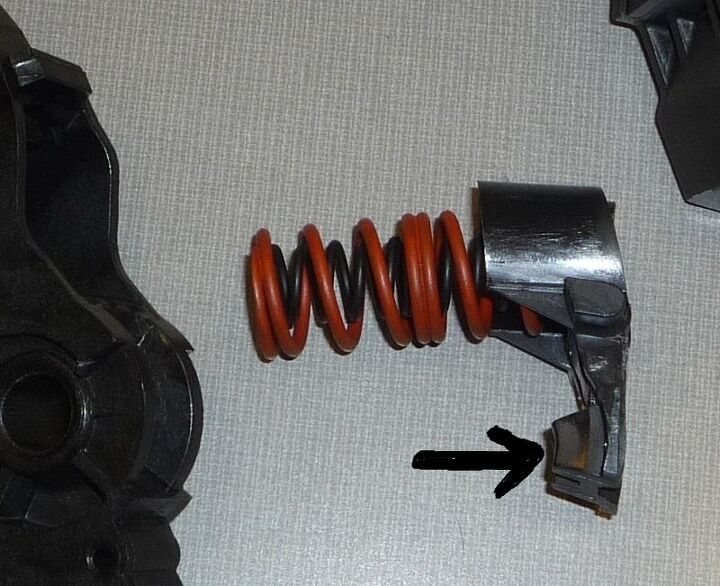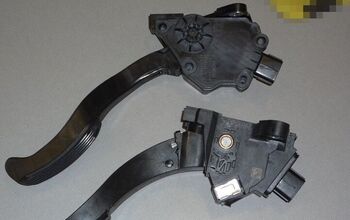TTAC Does The Toyota Pedal Shim Fix: Stop Gap Solution At Best

Update: a portal to all of TTAC’s articles on the subject of Toyota gas pedals is here:
Toyota has sent instructions and the shims for the field fix of the recalled sticky CTS gas pedals to dealers as of today. We have obtained the instructions (pdf here) [Hat Tip: Roxer], shims, and carried out the fix on a new CTS pedal accordingly. Follow along as we carry out the fix, and how we arrived at our unhappy conclusion.
The CTS pedal has a friction arm that is designed to generate a certain degree of friction necessary for the proper functioning of the electronic gas pedal. In our earlier tear down and analysis, we pointed out that the CTS design is inferior to others, such as the Denso unit also used in Toyotas. The friction arm is subject to wear and contamination that increases friction to the point of creating a sticky gas pedal.
The friction arm is a pivoted fulcrum; the end with the “friction teeth” rides in two grooved channels in the pedal assembly. Both these parts are made from plastic. The other end of the friction arm is held in place by the return spring, which exerts the pressure necessary to generate the friction. As the friction teeth wear, the gap on the other end increases in relation to the housing. Toyota’s shim is inserted in this gap in order to reduce/limit the amount of friction, and to compensate for wear.
The gap is to be measured by a feeler gauge (photo above), which determines the thickness of shim that is then inserted in the gap. The shim then limits the travel of the fulctum on the spring end, thereby reducing the amount of friction on the teeth as they ride in the grooves.
The next step is to open the gap by inserting a narrow-shank screwdriver, so that the correctly-sized shim can be installed. The unit has been turned upside down to facilitate that.
The shim (gray steel) is now slid in, and positioned behind a lip that serves to retain it. The shim is kept in place by the pressure of the return spring on the fulcrum, but we wonder whether a strong jolt might not be able to dislodge it. If it did become dislodged, it could potentially cause serious problems. No one would ever design a unit like this with a loose metal shim that was held in place by spring pressure only.
The next picture shows the shim all the way in place behind the lip. It’s a good thing that lip exists, otherwise this fix would not be possible.
The photo above shows the inside of the unit, with the friction arm extending forward. The shim is clearly visible as the shiny gray rectangle. The pivot axles extending out on both sides of the fulcrum/friction arm are visible as two small white/gray pieces, just below and to both sides of the shim. The friction teeth are visible towards the front of the unit, riding (now higher) in their grooves.
This photo above was taken previously of the same pedal. It’s difficult to tell exactly from the slightly different angles whether the teeth are riding higher with the shim, but it does appear so. And a subjective impression was that the pedal had somewhat less friction. So the fix may well reduce the friction below a dangerous level, but for how long?
The only way we interpret the necessity of measuring the friction arm gap and choosing an appropriately sized shim is that the older units with more wear will have a smaller gap than the new(er) ones. The shim will compensate for that wear, but in a static, not dynamic way. As soon as the continued wear on the friction arm changes its size or other friction characteristics, the pedal is potentially back to the same sticky situation as before.
The shim’s effect on reducing the amount of friction will presumably slow down the wear process, but intrinsically, this is not a permanent fix to a very critical part, from a safety point of view. This is why the CTS-type pedal design is flawed, because it is subject to changes in the amount of friction it generates due to wear and other factors.
The only other explanation for the varying gap size and different shims is that the manufacturing tolerances are so great, that this is necessary to compensate for them. That’s that hard to imagine, for such a critical part. But if so, it raises other serious questions about this unit. Either way, it reinforces our position that Toyota needs to replace all the CTS pedals with Denso pedals or another proven pedal design, as soon as they are available. The shim fix is a Band Aid, and does not inspire the confidence that Toyota urgently needs to instill in its customers and the market place at this critical time.
Update: Given that Toyota has acknowledged that these pedal assemblies cost them $15, it would obviously be cheaper (and more reliable) to swap out the CTS units with the Denso unit rather than this fussier and riskier fix. The problem is time; it could take many months if not a year or more to change tooling and produce 2.3 million units. Meanwhile, making these shims was obviously something that a stamping manufacturer could do in days.

More by Paul Niedermeyer
Latest Car Reviews
Read moreLatest Product Reviews
Read moreRecent Comments
- SPPPP I am actually a pretty big Alfa fan ... and that is why I hate this car.
- SCE to AUX They're spending billions on this venture, so I hope so.Investing during a lull in the EV market seems like a smart move - "buy low, sell high" and all that.Key for Honda will be achieving high efficiency in its EVs, something not everybody can do.
- ChristianWimmer It might be overpriced for most, but probably not for the affluent city-dwellers who these are targeted at - we have tons of them in Munich where I live so I “get it”. I just think these look so terribly cheap and weird from a design POV.
- NotMyCircusNotMyMonkeys so many people here fellating musks fat sack, or hodling the baggies for TSLA. which are you?
- Kwik_Shift_Pro4X Canadians are able to win?









































Comments
Join the conversation
Just my observations....I bought a 2010 Rav4 right before all this blew up in the news, and here's what I have noticed: Short little surges of power that occur occasionally such as the radio will go loud for a couple of seconds, and sometimes the car responds slightly too enthusiastically to the gas pedal, but does not continue to accelerate if I release the gas, although perhaps there is a split-second delay in response when I release the gas pedal. It is so subtle that I end up blaming it on myself by saying I must have pressed the gas harder than I thought, but I really do think there is a subtle intermittent electrical abnormality with these cars. It is not enough to make me want to take it in as I don't think the problem is frequent or severe enough for them to find anything wrong; neither do I feel unsafe. But I will keep an eye on it. I have also noticed the little brief surges in engine power only occur at speeds between 20-35 mph. Question: the guy who had issues with the prius accelerating to over 90 mph recently: why on earth did he not shift to neutral??? I heard he slammed foot and hand brakes but why not neutral as well? Do folks just panic and forget? I have practised this maneuver a few times - it sounds awful but it works! Anyone else notice similar issues with their toyotas?
I know this is an ancient thread, but I happened up a picture of a pedal sensor assembly for a modern Honda/Acura and was quite impressed by how much more substantial the design seems to be compared to either of Toyota's designs. Have a look: http://info.rockauto.com/getimage/getimage.php?imagekey=1514402&imageurl=http%3A//info.rockauto.com/SMP/APS148_FULL.jpg